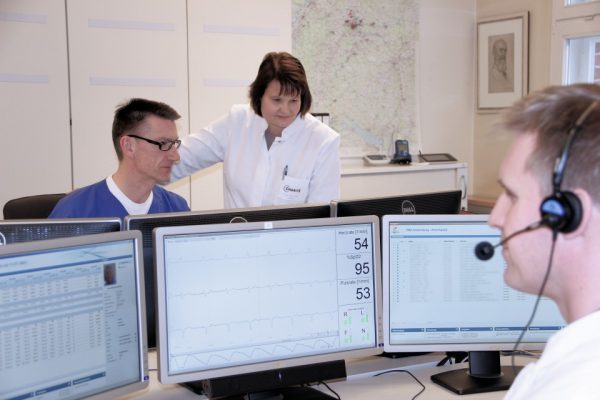
Berlin, 27.08.2018 – The Fontane study of the Charité – Universitätsmedizin Berlin has shown for the first time that telemedical care can prolong the lives of heart patients. In addition, telemedicine is equally suitable for patients in rural and metropolitan areas. The five-year study, in which more than 1,500 patients took part, was conducted with various partners and in close cooperation with two major health insurance companies. The Federal Ministry of Education and Research has funded the project with 10.2 million euros. The results have now been presented.
Approximately 1.8 million Germans suffer from chronic heart failure, and around 300,000 new cases are diagnosed each year. In the past ten years, it has been the most frequent cause of inpatient admissions. As part of the research project “Health Region of the Future North Brandenburg – Fontane”, more than 1,500 patients with this heart disease were examined by the Center for Cardiovascular Telemedicine at the Charité. Half of them received telemedical care, the other half remained treated conventionally. The medical care of the patients at their place of residence was guaranteed nationwide by 113 cardiological and 87 primary care institutions. The aim of the study was to be able to treat patients outside a hospital for as long as possible and to increase life expectancy and quality of life. In addition, it should be examined whether telemedicine can compensate for structural deficits in rural medical care compared to urban regions.
Thomas Rachel, Parliamentary State Secretary, Federal Ministry of Education and Research: “The results of the telemedicine study Fontane, financed by the Federal Ministry of Education and Research, show that the Fontane telemedicine study is a good example: Telemedicine works. It enables patients with cardiac insufficiency to be better cared for – regardless of whether they live in the countryside or in the city. The research results pave the way for the widespread use of telemedicine in Germany, so that hopefully all those affected will soon be able to benefit from better treatment quality. I am pleased that research on medical technology innovations is of direct benefit to patients. Here an outstanding success of telemedicine could be proven.”
The study results show that telemedicine patients had to spend fewer days in hospital and lived longer due to unplanned cardiovascular events: Based on the one-year study duration, they “lost” 17.8 days compared to 24.2 days in the control group. In addition, out of 100 heart failure patients, about 11 patients died in one year under normal conditions, whereas about 8 patients with telemedical co-care. There was also an advantage for the telemonitoring group during the unplanned hospital days due to heart failure with 3.8 compared to 5.6 days. These results were achieved regardless of whether the patient lived in a structurally weak rural area or in a metropolitan region. This makes telemedicine suitable for compensating regional differences in care between urban and rural areas and improving the overall quality of care.
Prof. Dr. Ulrich Frei, Medical Director of the Charité: “We were convinced of this forward-looking project right from the start and are all the more pleased that the results are so extremely positive. The telemedical service primarily serves patients, but it also strengthens family doctors in rural areas, who mainly take over the care of heart patients there. The result shows that telemedicine ensures the quality of patient care – regardless of where they live. It is also an outstanding example of how general practitioner care and university research at the Charité can work together in a very practical and transnational manner”.
The telemedically cared for patients received four measuring devices: an electrocardiogram (ECG) with finger clip for measuring the oxygen saturation, a blood pressure measuring device, a scale as well as a tablet for self-assessment of the state of health. The values were automatically transmitted to the Center for Cardiovascular Telemedicine at the Charité via the tablet. Doctors and nurses evaluated the transmitted data 24 hours a day, 7 days a week. For example, if the values deteriorated, they changed the medication, gave recommendations for an outpatient visit to the doctor or hospital admission.
Prof. Dr. Friedrich Köhler, head of the Fontane study at the Charité: “The study results show for the first time that telemedicine leads to a prolongation of life and fewer hospital stays in high-risk patients with cardiac insufficiency. Another decisive factor for our success was that we used a very simple technique that was also practical for patients in their everyday lives. In addition, we sent nursing staff directly to the patients, who trained them in the use of the devices and held structured telephone conversations with them every four weeks. Personal contact and close care have also made many patients more open to technology and telemedicine and motivated them to try it out. Another important task now is to develop an everyday model to treat a multiple of the number of patients in the study”.
Michael Scherf, CEO, GETEMED Medizin- und Informationstechnik AG: “We are very proud that we were able to accompany this milestone project from the very beginning as technical consortium leader. The outstanding research results developed by the Charité team in recent years have motivated us to continue investing in telemedicine products and to work on transferring innovative forms of care for chronically ill patients into regular care. In order to enable as many patients as possible to receive this form of care, solutions from the field of artificial intelligence must also be considered”.
Two large health insurance companies were also involved in the study as associated cooperation partners. Dr. Mani Rafii, Member of the Executive Board, BARMER: “The Fontane study is a prime example of how accurate telemedical applications are increasingly becoming an indispensable component of high-quality medical care. They not only close supply gaps
